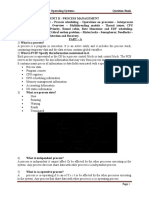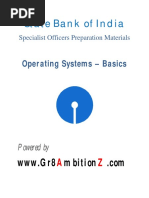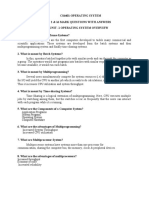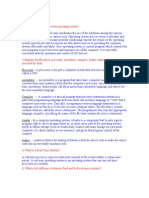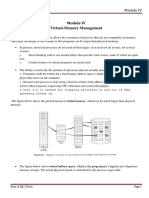Operating System Interview Question
Uploaded by
Ďarľïng KìrãnOperating System Interview Question
Uploaded by
Ďarľïng KìrãnOperating System Interview
Question
1) What is an operating system?
The operating system is a software program that facilitates computer hardware to
communicate and operate with the computer software. It is the most important part
of a computer system without it computer is just like a box.
2) What is the main purpose of an operating
system?
There are two main purposes of an operating system:
o It is designed to make sure that a computer system performs well by managing its
computational activities.
o It provides an environment for the development and execution of programs.
3) What are the different operating systems?
o Batched operating systems
o Distributed operating systems
o Timesharing operating systems
o Multi-programmed operating systems
o Real-time operating systems
4) What is a socket?
A socket is used to make connection between two applications. Endpoints of the
connection are called socket.
5) What is a real-time system?
Real-time system is used in the case when rigid-time requirements have been placed
on the operation of a processor. It contains a well defined and fixed time constraints.
6) What is kernel?
Kernel is the core and most important part of a computer operating system which
provides basic services for all parts of the OS.
7) What is monolithic kernel?
A monolithic kernel is a kernel which includes all operating system code is in single
executable image.
8) What do you mean by a process?
An executing program is known as process. There are two types of processes:
o Operating System Processes
o User Processes
9) What are the different states of a process?
A list of different states of process:
o New Process
o Running Process
o Waiting Process
o Ready Process
o Terminated ProcessDifference between JDK, JRE, and JVM
10) What is the difference between micro kernel
and macro kernel?
Micro kernel: micro kernel is the kernel which runs minimal performance affecting
services for operating system. In micro kernel operating system all other operations
are performed by processor.
Macro Kernel: Macro Kernel is a combination of micro and monolithic kernel.
11) What is the concept of reentrancy?
It is a very useful memory saving technique that is used for multi-programmed time
sharing systems. It provides functionality that multiple users can share a single copy
of program during the same period.
It has two key aspects:
o The program code cannot modify itself.
o The local data for each user process must be stored separately.
12) What is the difference between process and
program?
A program while running or executing is known as a process.
13) What is the use of paging in operating system?
Paging is used to solve the external fragmentation problem in operating system. This
technique ensures that the data you need is available as quickly as possible.
14) What is the concept of demand paging?
Demand paging specifies that if an area of memory is not currently being used, it is
swapped to disk to make room for an application's need.
15) What is the advantage of a multiprocessor
system?
As many as processors are increased, you will get the considerable increment in
throughput. It is cost effective also because they can share resources. So, the overall
reliability increases.
16) What is virtual memory?
Virtual memory is a very useful memory management technique which enables
processes to execute outside of memory. This technique is especially used when an
executing program cannot fit in the physical memory.
17) What is thrashing?
Thrashing is a phenomenon in virtual memory scheme when the processor spends
most of its time in swapping pages, rather than executing instructions.
18) What are the four necessary and sufficient
conditions behind the deadlock?
These are the 4 conditions:
Learn more
1) Mutual Exclusion Condition: It specifies that the resources involved are non-
sharable.
2) Hold and Wait Condition: It specifies that there must be a process that is holding
a resource already allocated to it while waiting for additional resource that are
currently being held by other processes.
3) No-Preemptive Condition: Resources cannot be taken away while they are being
used by processes.
4) Circular Wait Condition: It is an explanation of the second condition. It specifies
that the processes in the system form a circular list or a chain where each process in
the chain is waiting for a resource held by next process in the chain.
19) What is a thread?
A thread is a basic unit of CPU utilization. It consists of a thread ID, program counter,
register set and a stack.
20) What is FCFS?
FCFS stands for First Come, First Served. It is a type of scheduling algorithm. In this
scheme, if a process requests the CPU first, it is allocated to the CPU first. Its
implementation is managed by a FIFO queue.
21) What is SMP?
SMP stands for Symmetric MultiProcessing. It is the most common type of multiple
processor system. In SMP, each processor runs an identical copy of the operating
system, and these copies communicate with one another when required.
22) What is RAID? What are the different RAID
levels?
RAID stands for Redundant Array of Independent Disks. It is used to store the same
data redundantly to improve the overall performance.
Following are the different RAID levels:
RAID 0 - Stripped Disk Array without fault tolerance
RAID 1 - Mirroring and duplexing
RAID 2 - Memory-style error-correcting codes
RAID 3 - Bit-interleaved Parity
RAID 4 - Block-interleaved Parity
RAID 5 - Block-interleaved distributed Parity
RAID 6 - P+Q Redundancy
23) What is deadlock? Explain.
Deadlock is a specific situation or condition where two processes are waiting for each
other to complete so that they can start. But this situation causes hang for both of
them.
24) Which are the necessary conditions to achieve
a deadlock?
There are 4 necessary conditions to achieve a deadlock:
o Mutual Exclusion: At least one resource must be held in a non-sharable mode. If any
other process requests this resource, then that process must wait for the resource to
be released.
o Hold and Wait: A process must be simultaneously holding at least one resource and
waiting for at least one resource that is currently being held by some other process.
o No preemption: Once a process is holding a resource ( i.e. once its request has been
granted ), then that resource cannot be taken away from that process until the
process voluntarily releases it.
o Circular Wait: A set of processes { P0, P1, P2, . . ., PN } must exist such that every P[ i ]
is waiting for P[ ( i + 1 ) % ( N + 1 ) ].
Note: This condition implies the hold-and-wait condition, but it is easier to deal
with the conditions if the four are considered separately.
25) What is Banker's algorithm?
Banker's algorithm is used to avoid deadlock. It is the one of deadlock-avoidance
method. It is named as Banker's algorithm on the banking system where bank never
allocates available cash in such a manner that it can no longer satisfy the
requirements of all of its customers.
26) What is the difference between logical address
space and physical address space?
Logical address space specifies the address that is generated by CPU. On the other
hand physical address space specifies the address that is seen by the memory unit.
27) What is fragmentation?
Fragmentation is a phenomenon of memory wastage. It reduces the capacity and
performance because space is used inefficiently.
28) How many types of fragmentation occur in
Operating System?
There are two types of fragmentation:
o Internal fragmentation: It is occurred when we deal with the systems that have fixed
size allocation units.
o External fragmentation: It is occurred when we deal with systems that have
variable-size allocation units.
29) What is spooling?
Spooling is a process in which data is temporarily gathered to be used and executed
by a device, program or the system. It is associated with printing. When different
applications send output to the printer at the same time, spooling keeps these all
jobs into a disk file and queues them accordingly to the printer.
30) What is the difference between internal
commands and external commands?
Internal commands are the built-in part of the operating system while external
commands are the separate file programs that are stored in a separate folder or
directory.
31) What is semaphore?
Semaphore is a protected variable or abstract data type that is used to lock the
resource being used. The value of the semaphore indicates the status of a common
resource.
There are two types of semaphore:
o Binary semaphores
o Counting semaphores
32) What is a binary Semaphore?
Binary semaphore takes only 0 and 1 as value and used to implement mutual
exclusion and synchronize concurrent processes.
33) What is Belady's Anomaly?
Belady's Anomaly is also called FIFO anomaly. Usually, on increasing the number of
frames allocated to a process virtual memory, the process execution is faster,
because fewer page faults occur. Sometimes, the reverse happens, i.e., the execution
time increases even when more frames are allocated to the process. This is Belady's
Anomaly. This is true for certain page reference patterns.
34) What is starvation in Operating System?
Starvation is Resource management problem. In this problem, a waiting process does
not get the resources it needs for a long time because the resources are being
allocated to other processes.
35) What is aging in Operating System?
Aging is a technique used to avoid the starvation in resource scheduling system.
36) What are the advantages of multithreaded
programming?
A list of advantages of multithreaded programming:
o Enhance the responsiveness to the users.
o Resource sharing within the process.
o Economical
o Completely utilize the multiprocessing architecture.
37) What is the difference between logical and
physical address space?
Logical address specifies the address which is generated by the CPU whereas physical
address specifies to the address which is seen by the memory unit.
After fragmentation
38) What are overlays?
Overlays makes a process to be larger than the amount of memory allocated to it. It
ensures that only important instructions and data at any given time are kept in
memory.
39) When does trashing occur?
Thrashing specifies an instance of high paging activity. This happens when it is
spending more time paging instead of executing.
You might also like
- Operating System Interview Questions & AnswersNo ratings yetOperating System Interview Questions & Answers17 pages
- Operating System 2 Marks and 16 Marks - Answers75% (4)Operating System 2 Marks and 16 Marks - Answers45 pages
- Top 50 Operating System Interview Questions: 1) Explain The Main Purpose of An Operating System?No ratings yetTop 50 Operating System Interview Questions: 1) Explain The Main Purpose of An Operating System?11 pages
- 159 - CS8493, CS6401 Operating Systems - Important QuestionsNo ratings yet159 - CS8493, CS6401 Operating Systems - Important Questions16 pages
- Commonly Asked Operating Systems Interview QuestionsNo ratings yetCommonly Asked Operating Systems Interview Questions21 pages
- Sri Manakula Vinayagar Engineering CollegeNo ratings yetSri Manakula Vinayagar Engineering College21 pages
- Operating Systems: 1. Explain The Concept of ReentrancyNo ratings yetOperating Systems: 1. Explain The Concept of Reentrancy7 pages
- Important Questions in Operating SystemsNo ratings yetImportant Questions in Operating Systems6 pages
- Operating Systems: 1. Explain The Concept of Reentrancy100% (1)Operating Systems: 1. Explain The Concept of Reentrancy8 pages
- Operating Systems: 1. Explain The Concept of ReentrancyNo ratings yetOperating Systems: 1. Explain The Concept of Reentrancy7 pages
- SBI Specialist Officers - Operating SystemsNo ratings yetSBI Specialist Officers - Operating Systems10 pages
- Short Type S and Answers On: Operating SystemNo ratings yetShort Type S and Answers On: Operating System31 pages
- Information Technology: Things You Should Know (Questions and Answers)From EverandInformation Technology: Things You Should Know (Questions and Answers)No ratings yet
- Operating Systems: Concepts to Save Money, Time, and FrustrationFrom EverandOperating Systems: Concepts to Save Money, Time, and FrustrationNo ratings yet
- Introduction To DSM: Unit - III Essay QuestionsNo ratings yetIntroduction To DSM: Unit - III Essay Questions21 pages
- Operating System MCQ (Multiple Choice Questions) - SanfoundryNo ratings yetOperating System MCQ (Multiple Choice Questions) - Sanfoundry24 pages
- Multiple Choice Questions On Operating System Part100% (3)Multiple Choice Questions On Operating System Part24 pages
- Virtual Memory Management-Operating Systems100% (1)Virtual Memory Management-Operating Systems72 pages
- Top 100+ Operating System Interview Questions (20 2No ratings yetTop 100+ Operating System Interview Questions (20 24 pages
- Chapter 9: Virtual Memory: Silberschatz, Galvin and Gagne ©2013 Operating System Concepts - 9 Edition100% (1)Chapter 9: Virtual Memory: Silberschatz, Galvin and Gagne ©2013 Operating System Concepts - 9 Edition78 pages
- Top 50 Operating System Interview Questions: 1) Explain The Main Purpose of An Operating System?Top 50 Operating System Interview Questions: 1) Explain The Main Purpose of An Operating System?
- 159 - CS8493, CS6401 Operating Systems - Important Questions159 - CS8493, CS6401 Operating Systems - Important Questions
- Commonly Asked Operating Systems Interview QuestionsCommonly Asked Operating Systems Interview Questions
- Operating Systems: 1. Explain The Concept of ReentrancyOperating Systems: 1. Explain The Concept of Reentrancy
- Operating Systems: 1. Explain The Concept of ReentrancyOperating Systems: 1. Explain The Concept of Reentrancy
- Operating Systems: 1. Explain The Concept of ReentrancyOperating Systems: 1. Explain The Concept of Reentrancy
- Operating System Interview Questions and AnswersFrom EverandOperating System Interview Questions and Answers
- Information Technology: Things You Should Know (Questions and Answers)From EverandInformation Technology: Things You Should Know (Questions and Answers)
- Operating Systems: Concepts to Save Money, Time, and FrustrationFrom EverandOperating Systems: Concepts to Save Money, Time, and Frustration
- Operating System MCQ (Multiple Choice Questions) - SanfoundryOperating System MCQ (Multiple Choice Questions) - Sanfoundry
- Multiple Choice Questions On Operating System PartMultiple Choice Questions On Operating System Part
- Top 100+ Operating System Interview Questions (20 2Top 100+ Operating System Interview Questions (20 2
- Chapter 9: Virtual Memory: Silberschatz, Galvin and Gagne ©2013 Operating System Concepts - 9 EditionChapter 9: Virtual Memory: Silberschatz, Galvin and Gagne ©2013 Operating System Concepts - 9 Edition
























